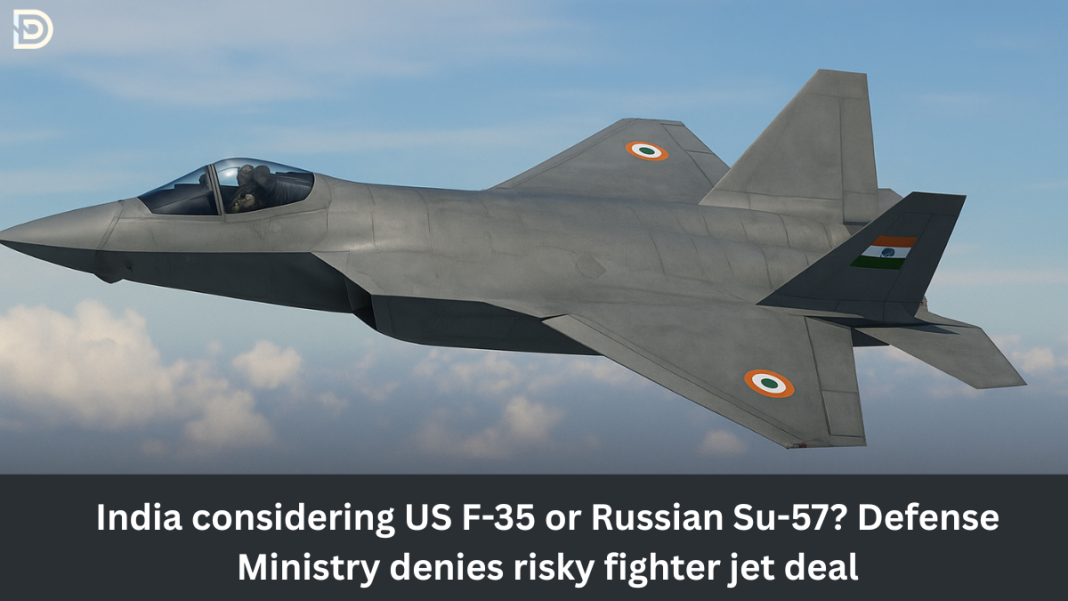India is not in any official talks with the United States or Russia to buy advanced stealth fighter jets like the F-35A or Su-57 E.
No Deal for F-35 or Su-57 Fighter Jets
This was clearly stated by the country’s defense leadership on Friday. According to the update, any discussions that happened with these countries were informal and not part of any formal defense negotiations.
Instead of purchasing these foreign-made fifth-generation fighter aircraft, India has chosen to focus its energy on building its own stealth fighter jet. This project is called the Advanced Medium Combat Aircraft (AMCA). The aim is to design and develop this jet completely in India. The estimated time to complete the AMCA project is around eight years.
This decision marks a major shift in India’s defense planning. Instead of depending on other countries for the most advanced military aircraft, India is working to strengthen its local defense manufacturing.
AMCA Project to be Built in India with Private Help
India is now moving ahead with the AMCA project in a new way. For the first time, private aerospace companies will be allowed to take part in the building of this aircraft. The country’s defense research organization has released a Request for Information (RFI). This document invites both public and private companies to show interest and share how they can help with the project.
✈️ Game Over for Stealth? India’s Radar Detects F-35, China’s J-35 Faces Reality Check
Until now, most military aircraft in India have been made by government-owned organizations. But this time, the doors are open for private companies as well. The goal is to ensure that India has more than one aircraft manufacturer. This could help build better jets, faster and more efficiently. Unlike the Russian Su-57, which is developed by a single state-owned firm, India aims to create a broader ecosystem involving multiple players.
The AMCA project will follow something called a “competitive execution model.” This means companies can either work alone, form a joint venture with others, or even create a consortium. In simple terms, a consortium is a group of companies working together. This model has been approved by the country’s top defense authority and is expected to bring a level playing field in India’s aerospace industry. Unlike Russia’s Su-57 program that remains closed to outside firms, India’s AMCA is setting a new example of openness.
By opening the doors to private players, the government wants to create competition. This will likely improve the quality of work, reduce delays, and increase the number of companies that can build fighter aircraft in India. This strategy stands in contrast to the Su-57 model, which has faced multiple production and export challenges due to limited industrial participation.
Indian Defense Sector Sees Shift from Russian Dependence
India has long depended on Russia for a large part of its military equipment. However, that reliance is now going down. A few years ago, around 65 to 70 percent of India’s defense gear came from Russia. But today, that number has dropped to about 40 percent.
This change has not been without challenges. There have been delays in the supply of defense equipment from many countries, including Russia, Israel, France, and the United States. For example, the delivery of the Russian-made S-400 missile systems has been pushed back. Still, the defense leadership mentioned that there is now a clear schedule and these systems are expected to arrive by April next year.
India’s S-400 Air Defense System Stops Missiles and Drones — But Each Intercept Costs $1.75 Million
Another area where delays have been felt is in the production of India’s Light Combat Aircraft (LCA). This is mainly due to engine supply issues from the United States. Despite this, the factory already has six years’ worth of orders waiting to be completed.
The idea of bringing in private players is also expected to help India’s only major aircraft maker so far. Even though this company has been the main player in military aircraft for decades, it has faced some production issues. The defense leadership believes that healthy competition will help even this established organization improve its performance.
India is no longer looking to other countries for fifth-generation fighter jets. The focus has clearly shifted to building these aircraft within the country, with both public and private companies working together. This is a big step toward making India more self-reliant in defense. It also shows a clear break from past practices where buying from foreign countries was the main option.

